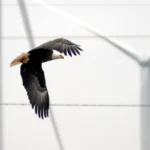Media Contact: Jordan Rutter, ABC Director of Public Relations, 202-888-7472 | jerutter@abcbirds.org | @JERutter
Expert Contact: Joel Merriman, ABC Bird-Smart Wind Energy Campaign Director, 202-888-7471 | jmerriman@abcbirds.org

Bald and Golden Eagles are among the species at risk from poorly sited wind turbines. Photo by Louise Redcorn
(Washington, D.C., May 11, 2020) When the New York State Legislature finalized the state budget, it included the Accelerated Renewable Energy Growth and Community Benefit Act. The Act seeks to streamline the approval process for wind and solar energy projects as part of the State’s approach to achieving its renewable energy goals. While it does have some positive elements for wildlife, such as seeking to site projects on degraded lands and creating a bird impact mitigation fund, the Act also fast-tracks facets of renewable energy planning and development, and changes in this process raise red flags with some conservation groups.
“We have concerns about how this will be implemented,” says Joel Merriman, ABC’s Bird-Smart Wind Energy Campaign Director. “A combination of aggressive timelines and the potential for automatic approvals at key steps in the process leaves the door open for wind energy facility plans to inadequately address risks to birds.”
Wind energy development is an important element of fighting climate change, but it does not come without environmental costs. ABC estimates that more than 500,000 birds are killed annually from collisions with wind turbines in the U.S. Given projected industry build-out, that figure is expected to increase to more than 1.4 million annually by 2030. Birds are also killed by powerlines installed to connect wind facilities to the energy grid, and yet others are displaced by facility development. Some species, such as Bald Eagles and Golden Eagles, are more vulnerable to turbine collisions, and due to slow reproductive rates, these birds have less capacity to recover from losses.
The Act creates a new Office of Renewable Energy Siting, which will work with other agencies to review and set conditions for proposed renewable energy projects. The input of wildlife management agencies will be crucial to ensure that birds receive adequate protection, but under the new law, these agencies are given short time windows to participate. Insufficient staffing, busy seasons, and many other factors could prevent meaningful review and input, potentially leaving birds largely out of the discussion.
Further, under the new law, local community input is substantially reduced and comes later in the planning process. This may prevent those with first-hand knowledge of local bird populations from influencing critical project elements that are determined early in the process, including facility and turbine siting.
“A lot hinges on development of strong standards and conditions for project siting and planning,” says Merriman. “These must ensure that local bird populations are thoroughly assessed, and that turbines are not sited in high-risk areas.”
For example, in an application filed for the Heritage Wind project in western New York in mid-March, the developer proposes placing wind turbines in close proximity to a large wetland complex that includes a National Wildlife Refuge and two state Wildlife Management Areas. Important to both breeding and migratory birds, this block of habitat supports many species of conservation concern and is also considered an Important Bird Area. During the planning process, two local bird conservation organizations raised concerns about the planned facility’s proximity to these sensitive areas, but these points have not been addressed by the developer.
“The bird-related conflict that poorly sited wind facilities create is largely avoidable if good siting practices are required,” says Merriman. “The State can greatly reduce this kind of conflict by establishing no-go zones and other commonsense standards to keep turbines out of high-risk areas.”
Merriman offers some broader advice on meeting renewable energy goals: “Renewable energy development is just one piece of the climate change solution puzzle,” he says. “We encourage the State to be equally aggressive in implementing energy efficiency measures and installing distributed solar energy. Put solar panels on commercial, municipal, and residential buildings, over parking lots…anywhere they can be supported. Birds and people win when energy production is sited where it’s used, away from valuable bird habitat.”
Merriman continues, “In other arenas, New York has done great things for birds. The State can maintain this commitment by making some adjustments to the Act, such as eliminating automatic approvals and setting a positive precedent in the development of standards and conditions for wind energy projects. A recent study by Cornell Lab of Ornithology, ABC, and others shows that the United States and Canada lost nearly 3 billion birds — almost 30 percent of the total population — since 1970. It’s critical that we balance the need for renewable energy development with protecting our vulnerable bird populations.”
ABC thanks the Leon Levy Foundation for its support of ABC’s Bird-Smart Wind Energy Campaign.
###
American Bird Conservancy is a nonprofit organization dedicated to conserving birds and their habitats throughout the Americas. With an emphasis on achieving results and working in partnership, we take on the greatest problems facing birds today, innovating and building on rapid advancements in science to halt extinctions, protect habitats, eliminate threats, and build capacity for bird conservation. Find us on abcbirds.org, Facebook, Instagram, and Twitter (@ABCbirds).